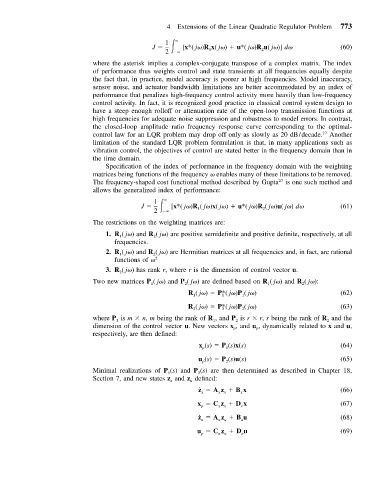Page 782 - Mechanical Engineers' Handbook (Volume 2)
P. 782
4 Extensions of the Linear Quadratic Regulator Problem 773
J
1
1
2
2 [x*( j )Rx( j ) u*( j )Ru( j )] d (60)
where the asterisk implies a complex-conjugate transpose of a complex matrix. The index
of performance thus weights control and state transients at all frequencies equally despite
the fact that, in practice, model accuracy is poorer at high frequencies. Model inaccuracy,
sensor noise, and actuator bandwidth limitations are better accommodated by an index of
performance that penalizes high-frequency control activity more heavily than low-frequency
control activity. In fact, it is recognized good practice in classical control system design to
have a steep enough rolloff or attenuation rate of the open-loop transmission functions at
high frequencies for adequate noise suppression and robustness to model errors. In contrast,
the closed-loop amplitude ratio frequency response curve corresponding to the optimal-
control law for an LQR problem may drop off only as slowly as 20 dB/decade. 27 Another
limitation of the standard LQR problem formulation is that, in many applications such as
vibration control, the objectives of control are stated better in the frequency domain than in
the time domain.
Specification of the index of performance in the frequency domain with the weighting
matrices being functions of the frequency enables many of these limitations to be removed.
27
The frequency-shaped cost functional method described by Gupta is one such method and
allows the generalized index of performance:
J
1
1
2
2 [x*( j )R ( j )x( j ) u*( j )R ( j )u( j ) d (61)
The restrictions on the weighting matrices are:
( j ) and R ( j ) are positive semidefinite and positive definite, respectively, at all
1. R 1 2
frequencies.
2. R ( j ) and R ( j ) are Hermitian matrices at all frequencies and, in fact, are rational
1 2
functions of 2
3. R ( j ) has rank r, where r is the dimension of control vector u.
2
( j ) and P ( j ) are defined based on R ( j ) and R ( j ):
Two new matrices P 1 2 1 2
R ( j ) P*( j )P ( j ) (62)
1
1
1
R ( j ) P*( j )P ( j ) (63)
2
2
2
where P is m n, m being the rank of R , and P is r r, r being the rank of R and the
2
1
1
2
dimension of the control vector u. New vectors x , and u , dynamically related to x and u,
p
p
respectively, are then defined:
x (s) P (s)x(s) (64)
p
1
u (s) P (s)u(s) (65)
p
2
Minimal realizations of P (s) and P (s) are then determined as described in Chapter 18,
1
2
Section 7, and new states z and z defined:
u
x
˙ z Az Bx (66)
x
x
x x
x Cz Dx (67)
p
x
x x
˙ z Az Bu (68)
u u
u
u
u Cz Du (69)
u u
u
p

